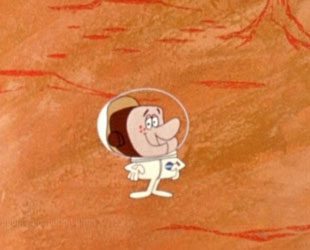July 8, 2008 — The stars of David Sington's first Apollo-inspired documentary, the 2007 critically-acclaimed "In The Shadow of the Moon," were astronauts with famous names, such as Buzz Aldrin, Mike Collins, Jim Lovell and Gene Cernan. The film, which makes its Science Channel debut on Friday, July 11 as part of the network's second annual Space Week, is airing alongside the second moon landing-themed project by Sington's production company, but this time, the spotlight is on the men and women who were behind the scenes, whose names — Joe Gavin, Bob Seamans, Eleanor Foraker and Sonny Morea — are not as well known or remembered.
"This is the story of the men and women who built the machines that took us to the Moon," announces narrator William Hope at the beginning of each of the six one-hour episodes of "Moon Machines," which premiered Sunday on Discovery Communications' Science Channel and runs through Thursday. As Hope explains, for each of the 24 astronauts who flew to the Moon, there were more than 16,000 engineers and technicians working to make their flights a success for a total greater than 400,000 people.
As its name suggests, "Moon Machines" organizes their stories by the hardware they worked to develop. Episodes are devoted to the Saturn V rocket that launched men to the Moon, the command and lunar modules that carried them there, the navigation computer that kept the craft on course, the spacesuits they wore to protect them and the rover they rode on to cross the lunar surface.
Like the earlier "Shadow," "Machines" matches archival footage with headshot interviews. The TV series diverges from the film's format to dramatic effect by adding scenes shot on-location, bridging the 1960s facilities to modern day life. Interview subjects are shown interacting with the equipment-turned-artifacts they helped develop to similar positive results.
The series also utilizes Apollo-era animations to explain what could be complicated subjects to a lay viewership. In one example, a cartoon illustrates the explanation of lunar orbit rendezvous, the "only" means of sending U.S. astronauts to the Moon, as was argued by engineer John Houbolt at the start of the lunar landing program. Another animation features "Andy Astronaut", who demonstrates the unfortunate effects of walking on the Moon without a spacesuit.

"Andy Astronaut" illustrates the need for a spacesuit. (Discovery) |
Not that "Moon Machines" avoids discussing complicated subjects. In a refreshing change from other recent efforts to present space history on film, "Machines" foregoes the more popular but often seen classic space shots for the more esoteric but just as engaging engineering films that documented NASA's try and fail and try, try again efforts to perfect the moon-bound equipment. Occasionally, the odd astronaut is shown walking on the lunar surface, but only when it serves to show the outcome, for example, of the spacesuits' design.
As the series' focus is more technical, one might guess it would be less interesting than the astronauts' adventures shown in "Shadow." To the contrary, the workers' stories are as enthralling, if not more so at times, due in no small part to the passion and pride that translates through their words to the small screen even 40 years later. But this is more than entertainment, as their recollections provide an important insight into how we reached the Moon at a time when our country has set its sights on returning there.
Take for example, George Phelps, the senior engineer at North American Aviation when NASA decided that weight needed to be stripped from the Saturn V's second stage. "Someone came up with an idea to remove one bulkhead. This was the biggest challenge on that stage," explained Phelps of the inch-thick wall that would separate the fuels where two dividers had previously been the norm. "That was the most difficult problem we had to resolve, but we did it because engineers can do just about anything," said Phelps, displaying a wide smile.
Humor notwithstanding, "Machines" is also poignant, with the realization that many of the leaders who would have been ideal to interview are no longer with us ("Machines" addresses this by including historians and authors among those on screen). This is especially felt by the inclusion of Bob Seamans, NASA's deputy administrator when the Apollo program began, who passed away the day prior to the series' premiere.
Thus, "Moon Machines" is not, as its title implies, about the hardware — although even space enthusiasts are sure to learn something new about the equipment — but as the opening narration reveals, the engineers in their shadow.
